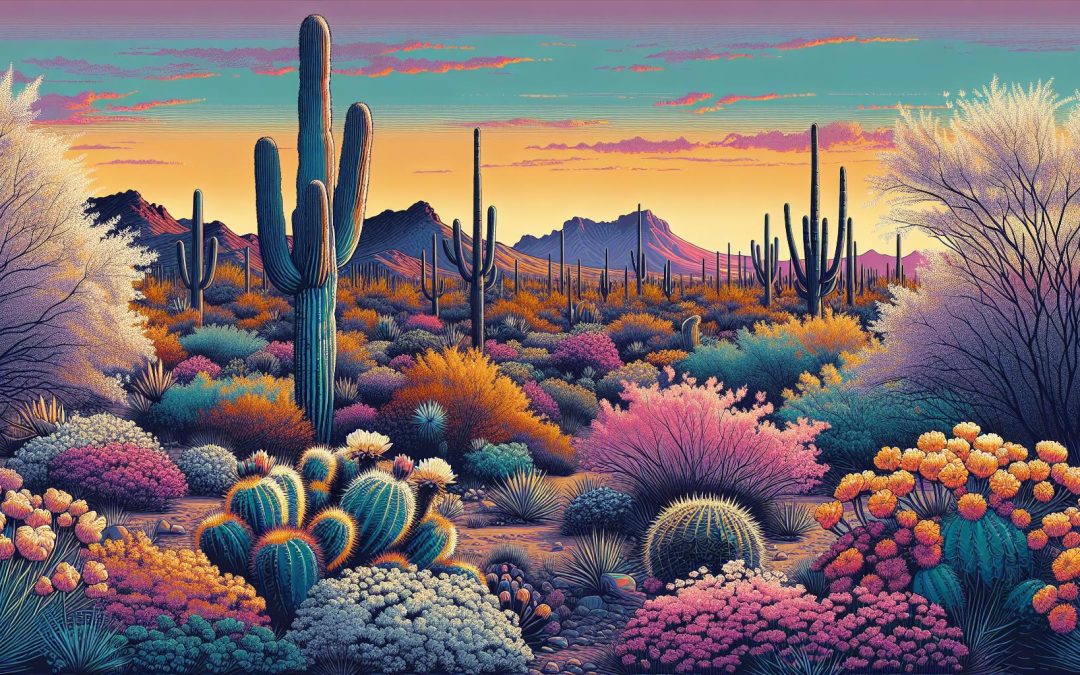Scottsdale, Arizona, isn’t just a haven for golf enthusiasts and spa-goers; it’s a photographer’s dream. With its sprawling deserts, vibrant sunsets, and iconic cacti, capturing its essence can be as rewarding as it is challenging. I’ve spent countless hours exploring and photographing this picturesque city, and I’ve gathered a handful of tips to help you make the most of your photographic journey.
From the fiery hues of the McDowell Sonoran Preserve at dawn to the architectural marvels that blend seamlessly with the landscape, Scottsdale’s beauty is diverse. Whether you’re a seasoned photographer or just starting out, there’s something magical about this place that begs to be captured. Let’s dive into some tips that’ll help you bring out the best in your Scottsdale landscape photos.
Choosing the Right Time of Day
When I set out to capture the splendid landscapes of Scottsdale, choosing the right time of day to shoot became as crucial as selecting my lens. Through trial and error, I’ve found that golden hours—just after sunrise or before sunset—create magic. These moments offer a soft, diffused light that enhances the natural beauty of the desert.
During my early visits, I quickly learned that the midday sun could be relentless, casting harsh shadows and washing out the vibrant colors of the landscape. But as the sun begins to set, the desert transforms. Colors become richer, and the shadows cast by the iconic cacti stretch long and dramatic across the sand. Here’s a quick breakdown of what I’ve discovered:
| Time of Day | Lighting Quality | Subject Recommendation |
|---|---|---|
| Early Morning | Soft, Warm | Cacti, Desert Floors |
| Midday | Harsh, Direct | Avoid if possible |
| Late Afternoon | Golden, Soft | Canyons, Mountains |
| Sunset | Dramatic, Colorful | Sky, Horizon |
Early mornings in Scottsdale are not to be missed. Not only is the temperature more bearable, but the soft morning light brings a serene quality to the landscape, perfect for capturing the tranquil beauty of the desert.
But, if you’re aiming for dramatic shots, the period just before the sun dips below the horizon, known as the blue hour, offers a cool, ethereal light that contrasts beautifully with the warm tones of the desert.
As I continued to explore different times of day, I also found value in shooting under overcast skies. While not as common in Scottsdale, cloudy days provide a natural diffusion of light, ideal for capturing the intricate details of the desert without the worry of harsh shadows or overexposure.
Experimenting with these times has not only taught me about patience and planning but has also pushed me to see Scottsdale’s landscapes in a new light—quite literally.
Finding Unique Perspectives

Having spent years capturing the beauty of Scottsdale, Arizona, I’ve learned that finding unique perspectives can transform a simple photo into a breathtaking composition. It’s all about viewing the landscape through fresh eyes and challenging oneself to see beyond the obvious.
One of my favorite methods to discover new angles is hiking off the beaten path. Scottsdale is surrounded by vast deserts and towering mountains, offering endless opportunities for exploration. By venturing away from popular spots, I’ve stumbled upon hidden gems that capture the essence of Arizona’s wilderness in a way that’s not commonly seen. I focus on looking for patterns and textures in the desert flora or finding contrasting elements, like the delicate bloom of a cactus against the rugged terrain.
Utilizing different lens types has significantly expanded my creative scope. A wide-angle lens, for instance, allows me to encompass vast desert landscapes into a single frame, emphasizing the grandeur of the scene. Conversely, a telephoto lens helps isolate distant features, like mountain peaks or a lone saguaro, creating a more intimate portrait of the landscape.
Another trick is to play with elevation. Climbing a hill or even using a drone offers a vantage point that reveals the landscape’s scale and beauty in unexpected ways. Aerial shots bring out the striking patterns and colors of the desert, adding a fresh perspective to the familiar terrains of Scottsdale.
Experimenting with these approaches has not only revitalized my photography portfolio but also deepened my appreciation for Scottsdale’s landscapes. By continually seeking unique perspectives and embracing the adventure that comes with it, I’ve been able to unveil sides of the desert that many might overlook.
Working with the Harsh Sunlight
One of the biggest challenges I’ve faced while photographing in Scottsdale, Arizona, is dealing with the harsh sunlight. You’d think the sun would be a photographer’s best friend, and it can be, but in the desert, it’s all about timing and technique. I’ve learned some valuable lessons along the way, and I’m eager to share them with you.
First off, the golden hours are your best bet for capturing the stunning landscapes here. This is the time right after sunrise or just before sunset when the light is softer and warmer. Photos taken during these times seem to have an inherent glow that highlights the beauty of the desert. However, this doesn’t mean you should pack up once the golden hours pass. There are plenty of opportunities throughout the day; it’s just a matter of how you handle the light.
When the sun’s at its peak, I’ve found that using a polarizing filter can be a game-changer. This nifty tool not only helps reduce the glare but also enhances the colors of the sky and the foliage, making them pop against the backdrop of the desert. Plus, it can help manage the reflections off water if you’re shooting near one of Scottsdale’s few but precious water bodies.
Shooting in harsh sunlight often means dealing with harsh shadows too. To counter this, I sometimes use a reflector to bounce some light back onto the darker areas of my subject. It’s a simple trick, but it can dramatically reduce the contrast in your photos, making them look more balanced.
Lastly, don’t shy away from the harsh sunlight. Embrace it. Sometimes, those stark contrasts and deep shadows can create compelling compositions that tell a story of resilience and beauty in the desert. It’s all about playing to the strengths of the environment and using the right techniques to capture it.
In the next part, we’ll delve into the importance of patience and persistence in landscape photography, particularly in an environment as dynamic as Scottsdale’s.
Incorporating Iconic Scottsdale Elements
While navigating the bright and vast landscapes of Scottsdale, it’s crucial to identify and incorporate elements that capture the essence of this breathtaking locale. Scottsdale isn’t just about the relentless sun and the expansive deserts; it’s home to iconic features that define its identity. From the saguaro cacti standing tall against the sky to the ancient Pueblo ruins that whisper tales of yesteryears, each element adds a layer of depth to your photographs.
One of the most remarkable features I’ve come across is the Superstition Mountains. These mountains aren’t just a backdrop; they’re a character in the story of Scottsdale. Capturing them during the golden hour, when their contours are softly lit, can add a magical ambiance to your shots. Another element not to be overlooked is the vibrant flora that defies the desert’s harsh conditions. The pops of color from flowers like the desert marigold or the fiery red of the ocotillo can transform a monotonous scene into a compelling composition.
Water bodies, although scarce, play a pivotal role too. When I stumbled upon the serene waters of the Salt River, it was a revelation. The contrast between the arid desert and the refreshing river created a juxtaposition that’s both striking and thought-provoking. Incorporating such elements requires patience, as the right lighting and angle can dramatically change the narrative of your photograph.
I’ve also learned the importance of integrating architectural elements that reflect Scottsdale’s unique blend of Native American and modern influences. Whether it’s the simple elegance of adobe homes or the bold lines of contemporary structures, these elements add a layer of complexity and contrast that enriches the storytelling aspect of your work.
Scottsdale is a tapestry of natural and man-made elements, each with its own story. By patiently waiting for the perfect light, framing your shots with thought, and embracing the richness of the landscape, you’ll be able to capture images that not only showcase Scottsdale’s beauty but also its soul.
Post-Processing Tips to Enhance Your Photos

After spending countless hours in the majestic landscapes of Scottsdale, capturing its essence through my lens, I always look forward to the post-processing stage. It’s here where my photographs really come to life, allowing me to accentuate the unique beauty of Scottsdale. I’ve gathered some invaluable tips over the years that I’d love to share with you.
First off, color correction is crucial. The vivid hues of Scottsdale’s flora and the dramatic skies can sometimes be lost or muted in raw photos. By adjusting the saturation and vibrance, you can bring these colors back to their natural glory. However, it’s vital to keep it realistic to maintain the authenticity of the scene.
Sharpening is another key aspect. Due to various factors, some of your shots might come out slightly softer than you’d prefer. A touch of sharpening can help define the edges in your landscapes, especially the intricate textures of the Superstition Mountains or the fine lines of the architecture. Just remember, a little goes a long way. Over-sharpening can make your images look unnatural.
Lastly, don’t underestimate the power of dodging and burning. This age-old technique allows you to manually brighten or darken areas of your image to direct the viewer’s eye. Want to highlight those stunning Scottsdale sunsets or the deep shadows cast by an ancient saguaro? Dodging and burning can help emphasize these elements, adding depth and drama to your photos.
These post-processing steps have always helped me infuse my Scottsdale landscapes with the vibrancy and emotion I experience while out in the field.
Conclusion
Mastering the art of photographing Scottsdale’s landscapes doesn’t end with just a click. It’s about breathing life into those captures through thoughtful post-processing. I’ve shared my go-to techniques to ensure your photos not only reflect Scottsdale’s beauty but also your unique perspective as a photographer. Remember, it’s about enhancing, not altering the essence of what you’ve captured. So grab your camera and let Scottsdale’s landscapes be your canvas. Happy shooting and editing!







